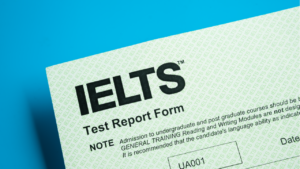All set for IELTS, but stuck with the Cue Card part? Try attempting the “Describe a Time You Moved to a New Home/School” IELTS Cue Card Sample.
The International English Language Testing System (IELTS) is a commonly opted language proficiency test. Accepted by more than 11,500 organisations across 140 countries, the test assesses your English language competence.
The IELTS consists of four modules: Reading, Writing, Listening and Speaking. The total duration of the test is 2 hours and 45 minutes.
While the Reading, Writing and Listening modules happen on the same day, the IELTS Speaking test can be conducted on the same day or a different.
The IELTS Speaking test remains the same for both the IELTS Academic and IELTS General Training tests.
The IELTS Speaking test is a face-to-face interview between the candidate and the examiner. The duration of the test is 11-14 minutes.
IELTS Speaking Overview:
| Duration | 11–14 minutes |
| Number of Parts | 3 |
| Band Score Range | 0-9 |
| Test Mode | Offline/Online |
Before appearing for your IELTS Speaking test, it is vital to understand how to answer a cue card topic. Here, the examiner analyses how you conceptualise an idea, frame your sentences, and convey it comprehensively.
This blog will discuss the IELTS cue card “Describe a Time You Moved to a New Home/school”. Check out the sample answers and follow-up questions to help you frame your answers.
Leap Advantage Virtual Spot Offer Event on May 10th 2024

Last call to secure your spot for Masters in STEM Program in the US for Fall ’24 exclusively for graduates and above.
Leap Advantage Virtual Spot Offer Event on May 10th 2024
Last call to secure your spot for Masters in STEM Program in the US for Fall ’24 exclusively for graduates and above.

IELTS Speaking Part 2: Cue Card
The IELTS Speaking consists of three parts. Each of these parts assesses your English language speaking skills.
The IELTS Speaking parts are:
- Part 1: Introduction and Interview (4 – 5 minutes)
- Part 2: Long turn or Cue Card (3 – 4 minutes)
- Part 3: Discussion (4 – 5 minutes)
The IELTS Cue Card section is the second part of the IELTS Speaking test. It is also referred to as the Individual Long Turn.
What is a Cue Card?

A cue refers to a call for action. And a cue card is a card given to the candidate by the examiner, which mentions a particular cue.
The cue card or task card will display a topic on which you are supposed to speak. The card will also provide 2-4 pointers on which you can elaborate on.
For example, Describe a cafe you visited, or Describe a Time When You Observed the Stars.
The duration of the cue card section is 3-4 minutes. A breakdown of the time is below.
Duration of IELTS Speaking Cue Card:
| Total Duration | 3-4 minutes |
| Preparation Time | 1 minute |
| Speaking Time | 2-3 minutes |
During the given preparation time, structure your answer correctly. The examiner will provide you with a pencil and paper. You can take notes of your essential points and refer to them later.
After the one-minute preparation time, the examiner will instruct you to start answering.
Your Speaking results are given as band scores, which range from a band 0 to a band 9. Each whole and half band score corresponds to a level of English-language competence.
Also, note that part 2 carries more weightage than part 1.
Also Read: IELTS Speaking Cue Card 2024: Topics, With Sample Answers
Crack IELTS Exam in first attempt

Attend Leap’s free masterclass to get tips, tricks and advance strategies to crack IELTS exam in first attempt
Crack IELTS Exam in first attempt
Attend Leap’s free masterclass to get tips, tricks and advance strategies to crack IELTS exam in first attempt

How to Answer the Cue Card: Describe a Time You Moved to a New Home/School
The first key to answering a cue card topic is structuring your answer within the given time. During your preparation time, plan your answer appropriately.
You can obey the following practices for better execution:
- Note down your main points in the paper such as the examples, definitions and references.
- Do not take a lot of time to make notes.
- Write down the keywords for your reference.
- Start your answer with a short introduction to the topic.
- Then, move to the explanation part. Explain with instances.
- In the end, give a short conclusion.
You can answer your cue card in any way convenient to you. One most recommended methods is to break down the topic into questions and answers.
Break down your topic into 3-4 basic questions. Then, answer each one of them in order. This will help you to cover all the main points under the given topic.
Let us break down the topic “Describe a Time You Moved to a New Home/school” into questions.
Major questions to cover:
- When did you move to the new home/school?
- Where did you move from and to?
- Why did you move into the new home/school?
- How did you feel about moving?
After breaking down into questions, answer each one of them. We have compiled a few sample answers for your reference. Check out how the answers are structured. Try to cover all the questions within the given time.
Sample Answers to Describe a Time You Moved to a New Home/School
We have compiled a few sample answers for your reference. You can refer to the structuring of the answers, grammatical style, tone and the vocabulary used in each.
Try to draft your answers based on the given samples.
Describe a Time You Moved to a New Home/School: Sample Answer 1
Sample 1 for the Describe a Time You Moved to a New Home/School cue card is below. Check out the answers and observe how the answer is being delivered.
Introduction:
I clearly remember the time when I moved into my new school. It was a very unique experience for me.
When did you move to the new home/school?
It was during my high school days. I was fourteen back then.
Where did you move from and to?
I did my early schooling at Duns Model School in Dehradun. I did my kindergarten and elementary studies there. It was a very serene and peaceful place. After my eighth class, I moved to Delhi for my higher education. I did the rest of my schooling at Delhi Public School.
Why did you move to the new home/school?
I had to move to Delhi because my father got a transfer to his Delhi office. So, my whole family relocated there.
How did you feel about moving?
It was a difficult time for me. It took quite a while for me to adjust to the new place. All my childhood, I lived in a small town that was very quiet and less crowded. On moving to Delhi, the city life felt completely new to me.
Conclusion:
However, I adjusted to the new setting after a couple of months. I made new friends in Delhi and slowly got used to the city vibes. Now, I have completely turned into a person who enjoys city life.
Describe a Time You Moved to a New Home/School: Sample Answer 2
See sample 2 for the Describe a Time You Moved to a New Home/School cue card. Check the flow of sentences and how the information is equally distributed between each answer.
Introduction:
My apartment is my comfort place. Even though I love travelling and hanging around outside, I always rush into my flat by the end of the day.
When did you move to the new home/school?
I bought my apartment a few years ago. If I remember correctly, it was in 2018.
Where did you move from and to?
Earlier, I used to stay with my parents in Gurgaon. I recently bought this new apartment, which is situated in the centre of New Delhi city.
Why did you move to the new home/school?
The main reason I shifted my flat is that earlier it was much more difficult for me to travel to my office every day. Now I live near my workplace. It is much easier for me to reach my office directly.
How did you feel about moving?
Initially, it took some time for me to find a good place with a proper view and lighting. Once I moved in, I loved it. It is so comfortable and cosy for me to live there. I got to experience several new things.
Conclusion:
Although adjusting to the new setting took a while, it was amusing and new for me. I would recommend living alone because it gives you a chance to experience several new things and you will also learn to manage things on your own.
IELTS Speaking Part 3: Discussion
After completing the cue card section, the discussion section is the third part of the IELTS Speaking test. The examiner will ask you a few questions based on your cue card.
Remember that it is the language of your answer that is relevant rather than your opinions. Make sure you answer with proper language structure, grammar, vocabulary and pronunciation.
We have provided sample questions for the cue card topic Describe a Time You Moved to a New Home/School. You refer to the sample answers to learn how to frame your sentences.
Check out the sample questions and their answers below.
Q1. What is the biggest challenge when moving to a new place?
Answer: The biggest challenge in moving to a new place can be subjective. For me, the most challenging task is to adjust to the cultural setting of the place. People who migrate or move into a foreign country often complain about the cultural shock. It can be challenging to understand and adjust to new faces.
Q2. What is a common reason why people move places?
Answer: People can move places for several reasons. Some of the common reasons are work and studies. People even migrate to a different country for better job opportunities and payments. These days, we see many students opting for foreign universities for their higher education.
Q3. What are the advantages of moving to a new place?
Answer: Moving to a new country or place opens up several new possibilities for you. It gives you a fresh start. You can try new food and try visiting new places. Moving to a new place also allows you to create new relationships.
Tips to Answer IELTS Cue Card
The IELTS Speaking tests are conducted by trained and certified IELTS examiners. They assess your performance with clearly defined criteria.
The assessment is conducted against 4 criteria
- Fluency and coherence
- Lexical resource
- Grammatical range and accuracy
- Pronunciation
The IELTS cue card section carries more weight than other parts. So, it is important you prepare well for the section.
Given are some good practices that will help you perform better in your IELTS cue card.
Check out the tips below:
- Understanding the Cue Card Topic: Read the cue card carefully to understand the task. Feel free to ask your examiner, if the topic is unclear.
- Utilise Your Preparation: Use your preparation time wisely. Note down your points, keywords, examples or references. Structure your answer according to the given time.
- Do Not Memorise Your Answers: You can memorise your main points but not the answer. Memorising your answers can give a negative impression to your examiner.
- Speak Fluently and Coherently: Make sure your answers are simple, clear and concise. Speaking fluently does not mean speaking fast. Maintain a constant and optimum pace.
- Check Grammar and Vocabulary: Grammatical accuracy is one of the four criteria on which your Speaking test is evaluated. Make sure your grammar, vocabulary, pronunciation and other elements are correct.
- Manage your Time Appropriately: Proper time management is extremely important during your IELTS Cue card section. Within the given short duration, make sure you cover all the points.
- Stay Calm and Confident: Try to remain confident throughout your test. Do not panic and maintain a proper posture.
The easiest measure to ace your IELTS cue card section is through constant practice. Make sure you attempt as many sample cue card topics as possible.
Practice Other IELTS Cue Cards
- IELTS Cue Card: Describe your Favourite Singer
- IELTS Cue Card: Describe A Person Who Wears Unusual Clothes
- IELTS Cue Card: Describe a Daily Routine That You Enjoy
- IELTS Cue Card: Describe a Chocolate You Didn’t Like
- IELTS Cue Card: Describe a Person Who you Believe Dresses Well
- IELTS Cue Card: Describe your Dream House
Brief Recap
IELTS Speaking is the shortest module among the four modules of the IELTS test. Although the duration is small, it is as important as the Reading, Writing and Listening modules. All of the tests carry the same weightage in terms of band score.
Start your IELTS Speaking preparation early. Try to attempt as many IELTS cue cards as possible. Pick any frequently asked IELTS cue card topics and try answering them.
Are you facing difficulty in preparing for your IELTS Speaking test? Then, start your IELTS preparation with Leap IELTS trainers. Get the right guidance from the right place.
Frequently Asked Questions
-
Q. Can I get preparation time for my cue card section?
A. Yes, you can get a preparation time for the cue card section. The duration of the preparation time is one minute. During this time, frame your answer appropriately. Prepare a short introduction. Find the main points to include in your answer. End with a small conclusion.
-
Q. How do you frame the answer for the cue card topic?
A. A commonly used method to answer your cue card topic is by breaking down the topic into 3-4 questions. This is to ensure that you cover each side of the topic. Explain its what, why, how and when elements for any given topic. For example, if your topic is Describe A Cafe You Like To Visit IELTS Cue Card, you can divide it into the following questions:
– What is the cafe called?
– Where is the cafe situated?
– Why do you like this particular cafe? -
Q. Can I make notes during my speaking cue card section?
A. Yes, you are allowed to make notes during your IELTS cue card section. The examiner will provide you with a pencil and paper. Write down the relevant points in it. You can use this for your reference. But make sure you do not spend too much time making notes.
-
Q. What is the duration of the IELTS cue card section?
A. The duration of your cue card section is 3-4 minutes. The first minute is the preparation time. You can use this time to prepare your answer well. Then, you will be given 2-3 minutes to speak. Structure your answer according to the time and jot down important ideas.
-
Q. What is the duration of the IELTS Speaking test?
A. The duration of the IELTS speaking test is 11-14 minutes. During this time, you will have to finish three different parts. The first part is the introduction, which lasts 4-5 minutes. Followed by the introductory part is the cue card section of 3-4 minutes. The third part is the discussion, comprised of 4-5 minutes.
-
Q. How many cue card topics will I have to answer for my IELTS speaking tests?
A. You must answer only one cue card topic for your IELTS Speaking test. The examiner will provide you with a topic. You will get a one-minute preparation time to frame your answer. After this, you have to speak about the given topic.
-
Q. How many parts are there in the IELTS speaking test?
A. The IELTS Speaking test consists of three parts. They are:
– Part 1: Introduction and Interview (4 – 5 minutes)
– Part 2: Individual Long turn or Cue Card (3 – 4 minutes)
– Part 3: Discussion (4 – 5 minutes) -
Q. What are some of the frequently asked IELTS cue card topics?
A. In general the cue cards are based on common topics such as interests, hobbies, experiences and situations. Some of the IELTS cue card topics are:
– Describe your Favourite Singer
– Describe A Person Who Wears Unusual Clothes
– Describe a Person Who you Believe Dresses Well
– Describe a Time When You Observed the Stars -
Q. What are some important elements to consider while answering my cue card task?
A. The objective of the cue card task is to analyse your English language proficiency. Some of the elements you can consider during the task are:
– Pronunciation: Use appropriate pronunciation
– Fluency: Speak fluently with a constant pace
– Coherence: Make sure your speech or text is coherent and simple
– Vocabulary: Use appropriate and varied vocabulary
– Grammar: Make sure you use the correct grammatical structures -
Q. Is pausing between my speech during the IELTS cue card section okay?
A. Pausing between your speech is acceptable, but make sure you do not pause longer. Take a moment to catch your beach or figure out what your next point can be. But don’t take too many pauses in between. This will give the impression to your examiner that you are stammering.
-
Q. What do I do if I make a grammar mistake during my cue card section?
A. If you make a grammar mistake during the cue card section, don’t dwell on it. Keep speaking confidently and naturally. Correct yourself if you catch the error, but prioritize fluency over perfection.
Here are some tips if you make an error:
– Keep Going
– Self-Correction
– If the mistake does not significantly impact the clarity of your response, you may choose to ignore it and proceed.
– Maintain Confidence







